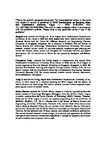Adaptive Neural Network Control of AUVs With Control Input Nonlinearities Using Reinforcement Learning
| dc.contributor.author | Cui, R | |
| dc.contributor.author | Yang, C | |
| dc.contributor.author | Li, Y | |
| dc.contributor.author | sharma, sanjay | |
| dc.date.accessioned | 2017-02-15T15:01:22Z | |
| dc.date.available | 2017-02-15T15:01:22Z | |
| dc.date.issued | 2017-01-11 | |
| dc.identifier.issn | 2168-2216 | |
| dc.identifier.issn | 2168-2232 | |
| dc.identifier.uri | http://hdl.handle.net/10026.1/8475 | |
| dc.description.abstract |
In this paper, we investigate the trajectory tracking problem for a fully actuated autonomous underwater vehicle (AUV) that moves in the horizontal plane. External disturbances, control input nonlinearities and model uncertainties are considered in our control design. Based on the dynamics model derived in the discrete-time domain, two neural networks (NNs), including a critic and an action NN, are integrated into our adaptive control design. The critic NN is introduced to evaluate the long-time performance of the designed control in the current time step, and the action NN is used to compensate for the unknown dynamics. To eliminate the AUV's control input nonlinearities, a compensation item is also designed in the adaptive control. Rigorous theoretical analysis is performed to prove the stability and performance of the proposed control law. Moreover, the robustness and effectiveness of the proposed control method are tested and validated through extensive numerical simulation results. | |
| dc.format.extent | 1019-1029 | |
| dc.language.iso | en | |
| dc.publisher | Institute of Electrical and Electronics Engineers (IEEE) | |
| dc.subject | Adaptive control | |
| dc.subject | autonomous underwater vehicle (AUV) | |
| dc.subject | neural network (NN) | |
| dc.subject | trajectory tracking | |
| dc.title | Adaptive Neural Network Control of AUVs With Control Input Nonlinearities Using Reinforcement Learning | |
| dc.type | journal-article | |
| dc.type | Journal Article | |
| plymouth.author-url | https://www.webofscience.com/api/gateway?GWVersion=2&SrcApp=PARTNER_APP&SrcAuth=LinksAMR&KeyUT=WOS:000401949500012&DestLinkType=FullRecord&DestApp=ALL_WOS&UsrCustomerID=11bb513d99f797142bcfeffcc58ea008 | |
| plymouth.issue | 6 | |
| plymouth.volume | 47 | |
| plymouth.publication-status | Published | |
| plymouth.journal | IEEE Transactions on Systems, Man, and Cybernetics | |
| dc.identifier.doi | 10.1109/TSMC.2016.2645699 | |
| plymouth.organisational-group | /Plymouth | |
| plymouth.organisational-group | /Plymouth/Faculty of Science and Engineering | |
| plymouth.organisational-group | /Plymouth/Faculty of Science and Engineering/School of Engineering, Computing and Mathematics | |
| plymouth.organisational-group | /Plymouth/REF 2021 Researchers by UoA | |
| plymouth.organisational-group | /Plymouth/REF 2021 Researchers by UoA/UoA11 Computer Science and Informatics | |
| plymouth.organisational-group | /Plymouth/REF 2021 Researchers by UoA/UoA12 Engineering | |
| plymouth.organisational-group | /Plymouth/Research Groups | |
| plymouth.organisational-group | /Plymouth/Research Groups/Marine Institute | |
| plymouth.organisational-group | /Plymouth/Users by role | |
| plymouth.organisational-group | /Plymouth/Users by role/Academics | |
| dcterms.dateAccepted | 2017-01-11 | |
| dc.identifier.eissn | 2168-2232 | |
| dc.rights.embargoperiod | No embargo | |
| rioxxterms.versionofrecord | 10.1109/TSMC.2016.2645699 | |
| rioxxterms.licenseref.uri | http://www.rioxx.net/licenses/all-rights-reserved | |
| rioxxterms.licenseref.startdate | 2017-01-11 | |
| rioxxterms.type | Journal Article/Review |


